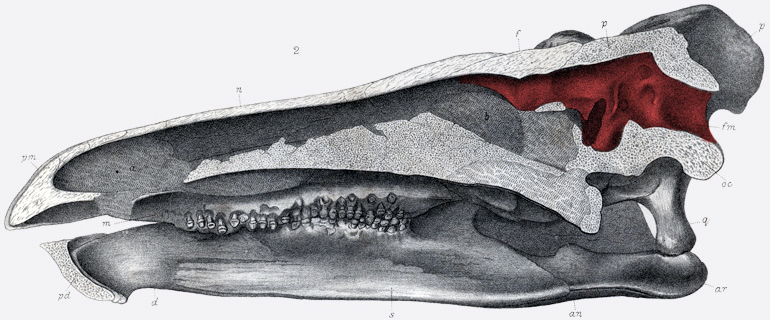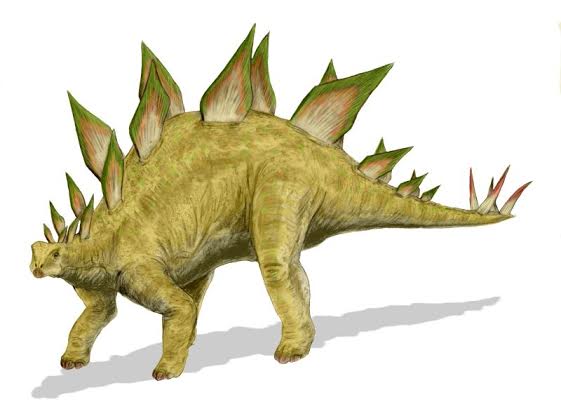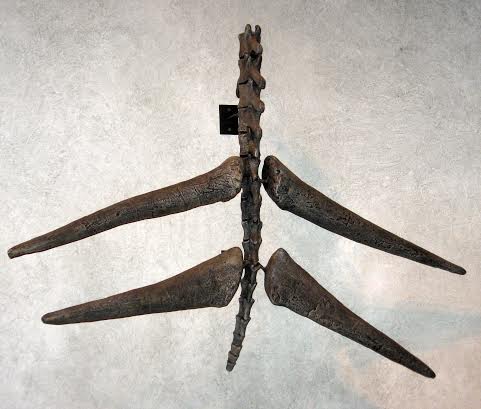Adaptation
The Stegosaurus stenops is a dinosaur that averaged a length of 7.4 meters and a weight of 1.78 metric tons (Glut 1997). From looking at any picture of this organism, it can be seen that the ancient creature has a very small head in comparison to its body. Also, it has four limbs that it stands on, so one can imagine how the large, muscular legs lumbered forward on the ground to provide movement for the organism. However, the major features that Stegosaurus is most known for would probably be its large, triangular plates located on its spine and the four spikes at the end of its tail. All of these features combined create what we picture this dinosaur to look like, but do you know what the purpose or uniqueness of these characteristics meant for the organism?
Head/Brain:
First, let’s discuss the animals small head. Many people have probably heard the description of a “walnut-sized” brain for the Stegosaurus, which is not far off base. This dinosaur brain weighed only 70 grams on average; however, it had large olfactory (smell) and optic (sight) lobes (Glut 1997). That means that the Stegosaurus would have an increased sense of sight and smell that could have helped it survive in its habitat by allowing it to find the food it needed and potentially see dangers before they got too close.
Limbs:
The dinosaur’s strong hind limbs would have allowed it to form a tripod-like stance with its tail resting on the ground too to allow it to feed on plants that were higher in the air (Glut 1997). By looking at the provided images, one can see how strong and long the animal’s hind legs look in comparison to the fore limbs.
Plates and Spikes:
There are many ideas about what the back plates that make this dinosaur so distinct are for. Some people believe that the plates were used for armor, but it is actually more likely that they were used for display and/or thermoregulation (Glut 1997). While the plates, which are not solid and actually show evidence of being filled with vascular tissue, have been assumed for much time to be used for defense, the spikes on the tail have been thought to be for offense (Hayashi et al. 2011). So unlike previously thought, Stegosaurus plates were most likely used for sexual display to be able to attract partners to allow reproduction and the passing on of genes to occur; also, they were used for thermoregulation to cool or warm the dinosaur’s body when needed (Glut 1997; Hayashi et al. 2011). As for the spikes, the idea that it was used for offense is probably false because Stegosaurus was an herbivore and did not need to hunt another animal for its food. Instead, it was most likely used as a defensive weapon in case it was ever attacked (Hayashi et al. 2011). For instance, it is thought that the Allosaurus was a predator to the Stegosaurus; in order for the Stegosaurus to protect itself, it would have needed to use its tail spikes (Carpenter et al. 2005). In fact, evidence of the spikes penetrating an Allosaurus’s vertebral column has been found and analyzed (Carpenter et al. 2005). With an estimated reference speed of 10m/s and high forces, a Stegosaurus tail had enough power in its muscles for the spikes to really pack a punch (Carpenter et al. 2005).
Continue on to check out Nutrition information for the Stegosaurus.
References Home MultipleOrganisms.net UW-La Crosse




